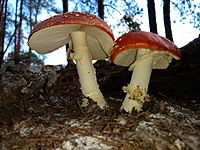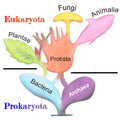
Back بوابة:فطريات Arabic Portál:Houby Czech Portail:Mycologie French Portale:Micologia Italian Vikisritis:Grybai Lithuanian Portaal:Schimmels Dutch Portal:Micologia Portuguese Портал:Микология Russian Портал:Гөмбәләр Tatar Portal:真菌 Chinese
The Fungi Portal
A fungus is any member of a large group of eukaryotic organisms that includes microorganisms such as yeasts and molds, as well as the more familiar mushrooms. The Fungi are classified as a kingdom that is separate from plants and animals. The discipline of biology devoted to the study of fungi is known as mycology or fungal biology, which is historically regarded as a branch of botany, even though genetic studies have shown that fungi are more closely related to animals than to plants. Fungi reproduce via spores and grow as hyphae, mycelia, and further specialized structures. Fungal spores are often produced on specialized structures or in fruiting bodies, such as the head of a mushroom. Abundant worldwide, most fungi are mostly invisible to the naked eye because of the small size of their structures, and their cryptic lifestyles in soil, on dead matter, and as symbionts of plants, animals, or other fungi. Fungi perform an essential role in the decomposition of organic matter and have fundamental roles in nutrient cycling and exchange. They have long been used as a direct source of food, such as mushrooms and truffles, as a leavening agent for bread, and in fermentation of various food products, such as wine, beer, and soy sauce.
Since the 1940s, fungi have been used for the production of antibiotics, and, more recently, various enzymes produced by fungi are used industrially and in detergents. Fungi are also used as biological agents to control weeds and pests. Many species produce bioactive compounds called mycotoxins, such as alkaloids and polyketides, that are toxic to animals including humans. The fruiting structures of a few species are consumed recreationally or in traditional ceremonies as a source of psychotropic compounds. Fungi can break down manufactured materials and buildings, and become significant pathogens of humans and other animals. Losses of crops due to fungal diseases or food spoilage can have a large impact on human food supplies and local economies. Despite their importance on human affairs, little is known of the true biodiversity of Kingdom Fungi, which has been estimated at around 1.5 million species, with about 5% of these having been formally classified.
| More about fungi... |
Selected article
The fungus grows in deciduous and coniferous forests and tree plantations, forming symbiotic ectomycorrhizal associations with living trees by enveloping sheaths of fungal tissue around their underground roots. The fungus produces spore-bearing fruit bodies above ground in summer and autumn. The fruit body consists of a large and imposing brown cap which on occasion can reach at least 35 cm (14 in) in diameter and 3 kg (6.6 lb) in weight. Like other boletes, it has tubes extending downward from the underside of the cap, rather than gills; spores are released at maturity through the tube openings, or pores. The pore surface of the B. edulis fruit body is whitish when young, but ages to a greenish-yellow. The stout stipe, or stem, is white or yellowish in colour, up to 25 cm (10 in) tall and 10 cm (3.9 in) thick, and partially covered with a raised network pattern, or reticulations.
Prized as an ingredient in various foods, B. edulis is an edible mushroom held in high regard in many cuisines, and is commonly prepared and eaten in soups, pasta, or risotto. The mushroom is low in fat and digestible carbohydrates, and high in protein, vitamins, minerals and dietary fibre. Although it is sold commercially, it has not been successfully grown in cultivation. Available fresh in autumn in Central, Southern and Northern Europe, it is most often dried, packaged and distributed worldwide. Keeping its flavour after drying, it is then reconstituted and used in cooking. Boletus edulis is one of the few fungi that are sold pickled. The fungus also produces a variety of organic compounds with a diverse spectrum of biological activity, including the steroid derivative ergosterol, a sugar binding protein, antiviral compounds, antioxidants, and phytochelatins, which give the organism resistance to toxic heavy metals.
Selected species
Things to do
If you want to help Wikipedia to improve its coverage of fungi, here are some things you can do...
- Assess some fungi articles.
- Join Wikipedia:WikiProject Fungi or ask on the talk page.
- Join the lichen task force.
- Review, improve, expand or clean some of the newly created fungi-related articles.
- Expand some high priority fungus stubs.
- Expand or sort other fungi-related stubs.
- Add images to articles in the list of unillustrated fungi articles, or add more articles to the list.
- Write fungi-related articles from scratch. For ideas of needed articles, see the redlinks on-
- Review the fungi articles flagged as needing attention.
WikiProjects
WikiProjects related to fungi:
Selected picture

Did you know?
- ... that the mushroom Stropharia ambigua has been said to taste like old leaves?
- ... that a humongous fungus caused a media stir after it was reported to cover an area of 37 acres (15 ha), weigh at least 21,000 pounds (10,000 kg), and be 1,500 years old?}
- ... that the mushroom Cortinarius archeri is featured on the cover of the book Fungi of Southern Australia?
- ... that the mushroom Russula integra is a popular food in Northern Europe?
- ... that Spongiforma, a sponge-like bolete newly described in 2009, smells like coal tar?
General images -
Related portals
Topics
- Main topics lists: Outline of fungi and Outline of lichens
- Fungi: Bracket fungus, carnivorous fungus, coprophilous fungi, entomopathogenic fungus, evolution of fungi, lichen, mushroom, mycology (lichenology, mycotoxicology, paleomycology), mycorrhiza, pathogenic fungi, puffball, wood-decay fungus
- Fungal orders: Chytridiomycota, Blastocladiomycota, Neocallimastigomycota, Zygomycota, Glomeromycota. Dikarya: Ascomycota, Basidiomycota
- Fungi lists: Species: Agaricus species, Amanita species, Boletus species, Cortinarius species, Cyathus species, Hygrocybe species, Hygrophorus species, Inocybe species, Lactarius species, Mycosphaerella species, Panaeolus species, Psilocybe species, Russula species, Scleroderma species Other lists: Mycology journals, psilocybin mushrooms
- Uses: Edible mushroom, mushroom poisoning, psilocybin mushrooms, mushroom hunting, fungiculture, fermentation, baker's yeast, mycoremediation, lichenometry, mushroom dye
Categories
© MMXXIII Rich X Search. We shall prevail. All rights reserved. Rich X Search







































![Image 36Pennate diatom from an Arctic meltpond, infected with two chytrid-like [zoo-]sporangium fungal pathogens (in false-colour red). Scale bar = 10 μm. (from Marine fungi)](http://upload.wikimedia.org/wikipedia/commons/thumb/b/b5/Pennate_diatom_infected_with_two_chytrid-like_fungal_pathogens.png/120px-Pennate_diatom_infected_with_two_chytrid-like_fungal_pathogens.png)























